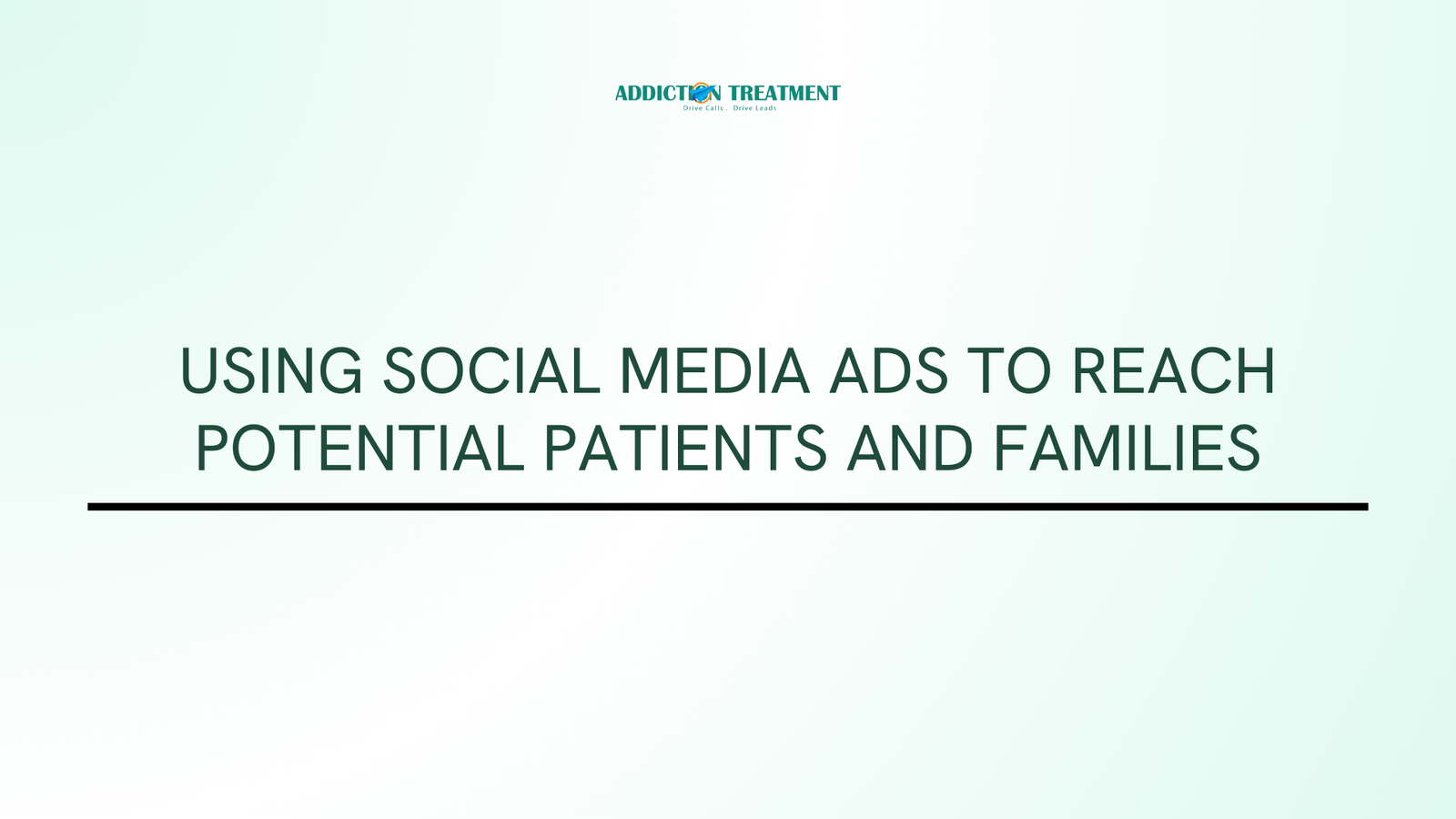Social media advertising has transformed how healthcare providers, including addiction treatment centers, connect with potential patients and their families. Platforms like Facebook, Instagram, LinkedIn, and YouTube provide powerful tools to target specific audiences, deliver compelling messages, and guide individuals toward seeking help. With billions of users globally, social media ads offer unparalleled reach, but achieving success requires strategy, empathy, and compliance.
This article explores how addiction treatment centers can use social media ads effectively to engage potential patients and families, while adhering to best practices and ethical guidelines.
Why Social Media Ads Are Effective for Addiction Treatment Marketing
Social media ads provide several advantages for addiction treatment centers:
- Precise Targeting: Platforms offer advanced targeting options based on demographics, interests, behaviors, and even life events.
- Widespread Reach: Social media platforms reach billions of users worldwide, making it easier to connect with potential patients and their families.
- Cost-Effective Advertising: Compared to traditional advertising methods, social media allows for flexible budgets and cost-effective campaigns.
- Engagement Opportunities: Ads can encourage users to interact, such as clicking for more information, sending messages, or filling out contact forms.
Best Social Media Platforms for Addiction Treatment Ads
1. Facebook
With its robust targeting options and large user base, Facebook is a go-to platform for reaching individuals and families.
- Benefits: Advanced targeting, lead generation forms, and detailed analytics.
- Ad Formats: Carousel ads, video ads, and boosted posts work particularly well.
2. Instagram
Instagram’s visual nature makes it ideal for sharing compelling imagery and videos about recovery and hope.
- Benefits: High engagement rates, especially among younger audiences.
- Ad Formats: Stories, reels, and in-feed ads can showcase success stories or facility tours.
3. LinkedIn
LinkedIn is effective for B2B campaigns targeting referral partners, corporate HR managers, or other professionals.
- Benefits: Ideal for networking and promoting professional resources.
- Ad Formats: Sponsored content and InMail ads for direct engagement.
4. YouTube
As a video-first platform, YouTube is perfect for sharing educational and inspirational content.
- Benefits: High engagement with video content and broad reach.
- Ad Formats: Skippable in-stream ads and non-skippable bumper ads are highly effective.
Crafting Effective Social Media Ads for Addiction Treatment
1. Understand Your Audience
Knowing your audience’s needs, concerns, and behaviors is essential for creating effective ads.
- For Potential Patients: Focus on messages of hope, recovery, and the benefits of seeking help.
- For Families: Address concerns like how to support a loved one or recognize the signs of addiction.
2. Use Empathetic Messaging
Addiction is a sensitive topic, so your ads should use compassionate and understanding language.
- Avoid fear-based tactics or judgmental tones.
- Highlight how your center provides a safe, supportive environment for recovery.
- Use phrases like “You’re not alone” or “Help is available.”
3. Incorporate High-Quality Visuals
Visual elements capture attention and convey emotion more effectively than text alone.
- Images: Use photos of your facility, therapy sessions, or serene environments that promote calm and recovery.
- Videos: Share testimonials, success stories, or informational videos about the recovery process.
- Design: Ensure ads are visually clean, professional, and mobile-friendly.
4. Leverage Targeting Features
Each platform offers unique targeting options to reach your ideal audience.
- Demographics: Age, gender, location, and language.
- Interests: Addiction recovery, mental health, or related topics.
- Behaviors: Recent searches or engagement with similar services.
- Custom Audiences: Retarget individuals who have visited your website or interacted with previous ads.
5. Offer Clear Calls-to-Action (CTAs)
Your ads should guide users toward the next step, such as:
- “Call Now to Speak with a Counselor.”
- “Download Our Free Guide to Understanding Addiction.”
- “Schedule a Confidential Consultation Today.”
Types of Social Media Ads for Addiction Treatment Marketing
1. Educational Ads
These ads provide valuable information to potential patients and their families.
- Example Topics:
- “Signs Your Loved One Needs Help with Addiction.”
- “How Inpatient Rehab Works.”
- Goal: Build trust and position your center as a knowledgeable resource.
2. Testimonial Ads
Sharing real-life success stories builds credibility and inspires hope.
- Example Content:
- Video testimonials from former patients.
- Written stories with photos or quotes.
- Goal: Highlight the effectiveness of your treatment programs.
3. Event Ads
Promote webinars, workshops, or open house events.
- Example Content:
- “Join Our Free Webinar: Supporting a Loved One in Recovery.”
- “Tour Our Facility Virtually – Register Today!”
- Goal: Encourage interaction and engagement with your services.
4. Awareness Campaigns
These ads focus on reaching a broad audience and spreading awareness about your services.
- Example Content:
- “Did You Know? 20 Million Americans Struggle with Addiction Each Year.”
- “Help Is Just a Call Away – Contact Us for Confidential Support.”
- Goal: Increase visibility and generate interest.
Best Practices for Running Social Media Ads
1. Test and Optimize
- Run A/B tests with different ad copy, visuals, and targeting options to identify what works best.
- Continuously monitor performance metrics like click-through rates (CTR) and conversions.
2. Follow Platform Policies
Ensure your ads comply with each platform’s advertising policies, especially for healthcare and addiction treatment.
- Avoid making guarantees or unrealistic claims.
- Highlight your certifications or accreditations to build trust.
3. Retarget Interested Users
Use retargeting campaigns to engage individuals who interacted with your website, ads, or social media pages but didn’t take further action.
Measuring the Success of Your Social Media Ads
To evaluate the effectiveness of your campaigns, track these key metrics:
- Impressions: The number of times your ad is shown.
- Click-Through Rate (CTR): The percentage of users who click on your ad after seeing it.
- Conversion Rate: The percentage of users who take the desired action, such as filling out a form or making a call.
- Cost Per Click (CPC): The amount you pay for each click on your ad.
- Return on Ad Spend (ROAS): The revenue generated for every dollar spent on ads.
Overcoming Challenges in Social Media Advertising for Addiction Treatment
1. Addressing Stigma
Focus on empathetic and non-judgmental messaging to combat stigma and encourage engagement.
2. Maintaining Compliance
Work with marketing professionals familiar with healthcare and addiction treatment advertising regulations to avoid violations.
3. Ad Fatigue
Rotate ad creatives and messages regularly to keep your audience engaged and prevent declining performance.
Future Trends in Social Media Advertising
- AI-Driven Targeting: Advanced algorithms will enhance targeting precision.
- Interactive Ads: Features like polls, quizzes, and augmented reality (AR) will make ads more engaging.
- Short-Form Video: Platforms like Instagram Reels and TikTok will continue to dominate with bite-sized, impactful content.
Conclusion
Social media advertising is a powerful way for addiction treatment centers to connect with potential patients and their families. By leveraging empathetic messaging, precise targeting, and engaging visuals, your center can create campaigns that inspire trust and encourage individuals to take the first step toward recovery. With careful planning, compliance, and ongoing optimization, social media ads can play a vital role in your overall marketing strategy.


Leave a Reply